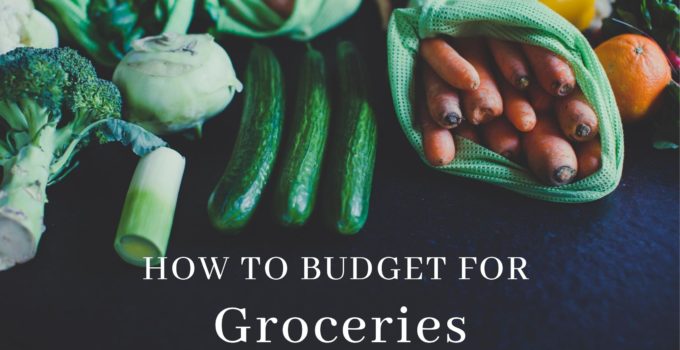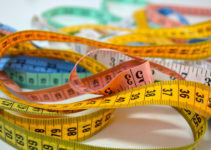Do you know how to budget for groceries? Or do you consistently go to the grocery store, fill your cart full of food, gotten home, and realize you have a lot of FOOD, but no MEALS? Do you go to the store to pick up “just a couple things” and end up spending three times what you thought you might? Or eat like a king right after your paycheck, but end up eating ramen the last few days before your next paycheck?
You might need to rethink how you budget for groceries. And you’ll notice that my first example doesn’t have anything to do with how much money you spend on your food – I’ve found that when people say that they’re unhappy with how much money they spend on food, they’re actually unhappy with HOW they spend their money on food, so we’re going to talk about that, too.
This post is focused on groceries, but you can use the tips for any category of spending you want to overhaul. If you’re looking to rethink your whole budget, I’d suggest this post.
So. How DO you budget for groceries?
Step 1: Assess how much you’re already spending on food.
Note the step doesn’t say “how much you’re already spending on groceries”. We’re talking about ALL food here. So pull out your credit card statement and bank statement and sit down and add up every food purchase you’ve made in the last month. Don’t lie to yourself, here – you’re the only one that’s going to look at this information!
If you’re just starting out on your own and have no idea how much food is going to cost, I’d suggest a little googling (Iowa State University has a low-cost food calculator here). Food costs are going to vary by city, so you might need to feed yourself for a week and start with that data.
Ok, do you have the total? Great. Are you happy with it? No? Also great! You can change it!
Now, break the total into three categories.
Food Cost Categories:
- Groceries
- Planned meals/snacks out
- Unplanned meals/snacks out
I’m going to say this right now: you will probably never get that last category to $0. Life is ALWAYS going to happen, so let’s be realistic and set ourselves up for success.

Step 2: Plan your meals
If you want to save money on food, it’s going to be best to build small habits that will lead to big $$ savings over time. But the single biggest thing you can do to reduce your food expenses is to make a meal plan.
Things to consider when building a meal plan:
- Decide how long you’re shopping for – and figure out how many meals you’ll need. I usually plan for a week. Then I write down any existing social plans (pizza at work on Friday, trivia night on Monday) and figure out how many recipes I need to dig up.
- Check what’s in your fridge. If you have some ingredients lingering in there, plan on using those first. Not only will this reduce your food waste, but it makes it easier to choose recipes!
- Fill in your meal plan. At this point, I’ll finagle the plan a bit – move similar meals further apart in the week, make sure we have enough leftovers for lunch on the day after we eat out for dinner, etc.
- Check your pantry for staples. After a few months of food planning, you’ll get a feel for what items you need to keep on hand. Oils, onions, garlic, canned tomatoes, flour, and cooking wine will all get added to the list first if we’re running low.
- Complete your shopping list. Pull out your recipes and add anything to your list that you don’t have. If you do this all at once, you’ll buy the Goldilocks amount of each ingredient – not too many because you didn’t realize there was a lemon hiding under the apples in your fruit bowl; not too few because you didn’t realize you needed a can of tomatoes for the pasta AND the stew.
Meals? Planned. Groceries? Shopped. All done, right? WRONG. There’s one more step!
Step 3: How to Adjust Your Budget for Groceries
After about a month of meal planning, you’re going to want to revisit the information that you gathered in Step 1. Pull out your categorized expenses from that month. Now sit down and categorize THIS month’s expenses. Add up all three categories (groceries, planned outings, unplanned outings). Compare it to last month’s – what do you notice?
If you’ve reduced your spending, congratulations, the meal plan worked! But if the result isn’t quite what you wanted, don’t consider yourself a failure. You might need to find another tactic or adjust your expectations on food cost.
I’ve found that life changes are made up of many smaller steps. If you want to improve something (like grocery spending), it’s going to take several rounds of planning, executing strategies, and then evaluating how it went. Over time, small adjustments will lead to systems that don’t take much effort and fit your life perfectly.
One more thing– sometimes, life circumstances can shift, shifting your priorities. It could be as simple as joining a social sports league and going out for dinner and drinks after each game. That will make your planned outing budget go up – but that’s not a BAD thing, it’s just a different way you’re spending your money!
At the end of the day, the point of this exercise is to get a better idea of how much money you’ll be spending on food in a month. There’s a lot of pressure to be frugal and get that amount as low as possible, but the reality is that (1) humans are social creatures that tend to gather over food; and (2) food costs money. This means that you will never get your food cost down to zero. But if you’re being deliberate how you budget for groceries, you’ll have more peace of mind.



